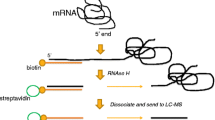Summary
The combination of pyronin, methyl green, malachite green, crystal violet, and Alcian Blue with a large number of polynucleotides and acidic polysaccharides has been investigated. The “critical electrolyte concentration” approach has been used to provide a measure of affinity between dye and substrate.
The interaction of methyl green with DNA, RNA and heparin has been examined spectroscopically.
Previously published results are re-examined, and with the new experiments permit consistent interpretations of the specificities of dye binding in terms of modern ideas of nucleic acid and dye structure.
All dyestuffs except Alcian Blue bind more strongly to polynucleotides than would be expected if solely electrostatic bonds were present. Pyronin and planar monovalent cationic dyes interact best with polynucleotides in which purine and pyrimidine bases are freely accessible, as in single stranded molecules without extensive secondary structure, such as RNA, denatured DNA, etc. Non-planar triphenylmethane dyes, e.g. methyl green, malachite green etc. bind less strongly to such substrates, but because of their shape they fit well into the secondary structure of native DNA. Tumour RNA and DNA did not differ from “normal” RNA and DNA.
By varying the electrolyte concentration, pyronin-methyl green selectivity e.g. for DNA or RNA, can be controlled, and non-nucleotide staining suppressed. The relevance of the new interpretation to the ribonuclease-pyronin technique is discussed.
Similar content being viewed by others
Bibliography
Barker, C. C., M. H. Bride, G. Hallas, and A. Stamp: Steric effects in di- and tri-aryl-methanes, pt. III —Electronic absorption spectra of derivatives of malachite green containing substituents in the phenyl ring. J. chem. Soc. 1961, 1285–1290.
Brachet, J.: The use of basic dyes and ribonuclease for the cytochemical detection of ribonucleic acid. Quart. J. micr. Sci. 94, 1–10 (1953).
Drummond, D. S., F. W. Simpson-Gildemeister, and A. R. Peacocke: Interaction of aminoacridines with deoxyribonucleic acid: effects of ionic strength, denaturation and structure. Biopolymers 3, 135–153 (1965).
Gomes de Mesquita, A. H., C. H. MacGillavry, and K. Eriks: The structure of triphenylmethyl perchlorate at 85°C. Acta Cryst. 18, 437–443 (1965).
Kasten, F. H.: Comparisons of pyronin dyes obtained from various commercial sources. I. History. Stain Technol. 37, 265–275 (1962).
Kelly, J. W., G. D. Bloom, and J. E. Scott: Quaternary ammonium compounds in connective tissue histochemistry. I. Selective unblocking. J. Histochem. Cytochem. 11, 791–798 (1963).
Kirby, K. S.: A new method for the isolation of deoxyribonucleic acids: evidence on the nature of bonds between deoxyribonucleic acid and protein. Biochem. J. 66, 495–504 (1957).
—: Countercurrent distribution of ribonucleic acids, III. Biochim. biophys. Acta. (Amst.) 61, 506–512 (1962).
—: Isolation and characterisation of ribosomal ribonucleic acid. Biochem. J. 96, 266–269 (1965).
Kurnick, N. B.: Mechanism of desoxyribonuclease depolymerisation: Effect of physical and enzymatic depolymerisation on the affinity of methyl green and of desoxyribonuclease for desoxyribonucleic acid. J. Amer. chem. Soc. 76, 417–424 (1954).
—: Histochemistry of nucleic acids. Int. Rev. Cytol. 4, 221–268 (1955).
—, and M. W. Foster: Methyl green, III. Reaction with desoxyribonucleic acid, stoichiometry, behaviour of the reaction product. J. gen. Physiol. 34, 147–159 (1950).
—, and I. E. Radcliffe: Reaction between DNA and quinacrine and other antimalarials. J. Lab. clin. Med. 60, 669–688 (1962).
Lawley, P. D.: Interaction studies with DNA. I. The binding of rosaniline at low ratio of concentrations rosaniline: DNA, and competitive effect of sodium and other metal cations. Biochem. biophys. Acta (Amst.) 19, 160–167 (1956).
—: Interaction studies with DNA. IV. Binding of 5-aminoacridine studied fluorimetrically and its comparison with the binding of rosaniline. Biochim. biophys. Acta (Amst.) 22, 451–458 (1956).
Lerman, L. S.: Amino group reactivity in DNA-aminoacridine complexes. J. molec. Biol. 10, 367–380 (1964).
Lewis, G. N., T. T. Magel, and D. Lipkin: Isomers of crystal violet ion. Their absorption and re-emission of light. J. Amer. chem. Soc. 64, 1774–1782 (1942).
Lison, L.: Histochemie et cytochimie animales, 3. ed., vol. 1, p. 384. Paris: Gauthier-Villars 1960.
Rosenkranz, H. S., and A. Bendich: On the nature of the deoxyribonucleic acid — methyl green reaction. J. biophys. biochem. Cytol. 4, 663–664 (1958).
Sainte-Marie, G.: A paraffin embedding technique for studies employing immunofluorescence. J. Histochem. Cytochem. 10, 250–254 (1962).
Sharp, D. W. A., and N. Sheppard: Complex fluorides, pt. VIII. The preparation and properties of salts of the triphenylmethyl cation: the infrared spectrum and configuration of the ion. J. chem. Soc. 674–682 (1957).
Scott, J. E.: Aliphatic ammonium salts in the assay of acidic polysaccharides from tissuses. Methods of biochemical analysis (ed.) D. Glick, vol. 8, p. 145–197. New York: Interscience Publ. 1960.
- The fractionation of polyanions by long-chain aliphatic ammonium salts. Biochem. J. 78, 24 P. (1961).
—: A new classification of cationic dyes based on their affinity for ionised groups of polyanions. Biochem. J. 99, 3–4P. (1966).
—, and J. Dorling: Differential staining of acid glycosaminoglycans (mucopolysaccharides) by alcian blue in salt solutions. Histochemie 5, 221–233 (1965).
—, G. Quintarelli, and M. C. Dellovo: The chemical and histochemical properties of alcian blue, I. The mechanism of alcian blue staining. Histochemie 4, 73–85 (1964).
—, and I. Willett: Binding of cationic dyes to nucleic acids and other biological polyanions. Nature (Lond.) 209, 985–987 (1966).
Stockwell, R. A., and J. E. Scott: Observations on the acid glycosaminoglycan (mucopolysaccharide) content of the matrix of ageing cartilage. Ann. rheum. Dis. 24, 341–350 (1965).
Tubbs, R. K., W. E. Ditmars jr., and Q. van Winkle: Heterogeneity of the interaction of DNA with acriflavine. J. molec. Biol. 9, 545–557 (1964).
Author information
Authors and Affiliations
Rights and permissions
About this article
Cite this article
Scott, J.E. On the mechanism of the methyl green-pyronin stain for nucleic acids. Histochemie 9, 30–47 (1967). https://doi.org/10.1007/BF00281805
Received:
Issue Date:
DOI: https://doi.org/10.1007/BF00281805




